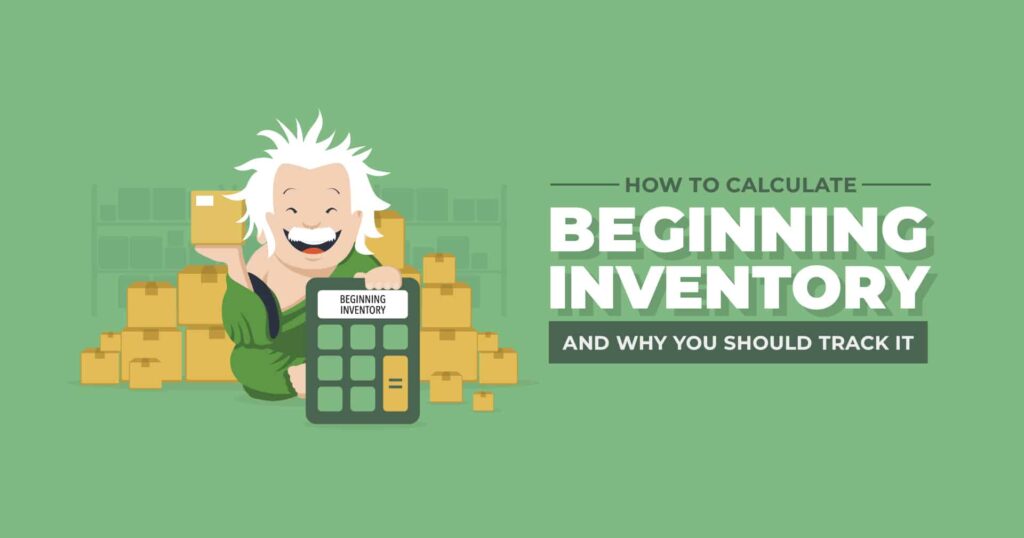There are a lot of accounting terms thrown around when describing eCommerce inventory: merchandise inventory, WIP inventory, ending inventory, and beginning inventory to name just a few. Unless you’re a CPA, the differences are subtle and can be confusing. Even though you don’t need an accounting degree to run an eCommerce business, it is helpful to know a few important terms, like beginning inventory, and understand why you should track it.
What is Beginning Inventory?
Beginning inventory is just what it sounds like, the value of the inventory you have in stock at the beginning of a specific accounting period. Let’s break that down.
- By inventory, we mean finished goods that are on hand and ready to sell. That means we’re not counting raw materials, goods in the process of being manufactured, goods you ordered but haven’t paid for yet, or goods you already sold but haven’t shipped out yet.
- By value, we mean how much that inventory cost to make or purchase, plus how much it’s costing you to store it. It’s the cash you have tied up in that inventory.
- A specific accounting period might be the beginning of the year, the quarter, or the month—i.e. however often you’re counting inventory. Most companies perform a physical count at least once a year, but if your eCommerce fulfillment warehouse has a perpetual inventory system you’re tracking inventory 24/7/365.
Why Do I Need to Track Beginning Inventory?
For an eCommerce business, inventory is your most valuable asset (at least in terms of bookkeeping) and also one of your largest costs. Tracking it from month to month and year to year helps with demand forecasting, preventing overstocks and stock outs, determining reorder points, identifying cyclical sales trends, and catching discrepancies due to error or shrinkage. Carrying too much inventory can eat into profitability, while carrying too little can negatively affect customer service.
To be clear, you don’t necessarily have to track beginning inventory; ending inventory works too. Because as you’re about to see, tracking either one over time will give you the same insights.
Beginning Inventory vs. Ending Inventory
If beginning inventory is the value of your inventory at the beginning of an accounting period, then ending inventory is its value at the end of an accounting period. The two numbers go hand in hand. You need one to calculate the other, and sometimes they’re the same number; i.e. the ending inventory for your last accounting period is the same number you’ll plug in as the beginning inventory for the next accounting period.
How to Calculate Beginning Inventory
The easiest way to calculate beginning inventory is to not calculate it at all. If you have last month’s (or year’s or quarter’s) ending inventory, that’s your beginning inventory for this period. But say this is your very first accounting period as a business and you want to calculate beginning inventory for recordkeeping purposes—You can do it by working backward from your ending inventory. To calculate beginning inventory, the numbers you’ll need are:
- Ending Inventory: the value of the current period’s ending inventory
- Purchases: cost of new inventory added during the period
- Cost of Goods Sold (COGS): cost of inventory sold during the period
Once you have these numbers, you can plug them into the following formulas to calculate beginning inventory and ending inventory.
Ending Inventory + COGS – Purchases = Beginning Inventory
Beginning Inventory + Purchases – COGS = Ending Inventory
Calculating Inventory Costs
The value of your inventory is always expressed as a dollar amount because it represents the costs you put into acquiring it and the amount of cash you have tied up in it. But what specifically goes into calculating those costs?
- For eCommerce manufacturers, this number includes the cost of the raw materials used, freight and storage costs, direct labor, storage, and all manufacturing costs including indirect labor, overhead, depreciation of machinery, utilities, etc.
- For eCommerce merchants and retailers, this number includes the purchase price and the carrying/holding costs associated with stocking and storing inventory in a warehouse.
- You’ll need to calculate the cost per unit of each item of inventory in stock then multiply that by the number of units, whether you’re calculating beginning inventory, ending inventory, or all merchandise inventory. For more on this, read our blog Merchandise Inventory Tracking and Accounting.
But what if those costs change during the month or year? That’s where cost flow assumptions, also called “inventory accounting methods” or “valuation methods,” come into play.
Inventory Accounting Methods
Three cost flow assumptions are commonly used to account for changing costs of inventory: FIFO (first in, first out) , LIFO (last in, last out) and Weighted Average. A fourth (less dominant) method known as Specific Identification involves assigning a specific cost to each individual item in stock; this method is impractical for most eCommerce businesses and retailers.
Using one of the above inventory valuation methods, each unit of inventory in stock is assigned a cost, which may or may not match its actual purchase price. As inventory flows through the business and costs rise or fall, there may be several different costs associated with the same SKU or the costs may be averaged, depending on the method chosen. Cost flow assumptions are simply a way to account for rising or falling costs, so they are reflected when calculating assets and net income at the end of the year.
Ecommerce Fulfillment Software Makes Calculations Easier
A 3PL such as ShipMonk has the systems in place to track eCommerce inventory in real time. Our warehouse fulfillment software fully integrates with your accounting, inventory
management systems, and/or ERP systems—making inventory calculations and end-of-year reporting simple. Any and all members of your organization can have access to these numbers.
And what happens when your inventory is distributed to multiple warehouses throughout the country? While this strategy enables faster deliveries and reduces shipping costs, it can make order routing and inventory tracking more difficult. However, if your eCommerce fulfillment provider manages its own warehouses, like ShipMonk does, their fulfillment software lets you see and manage inventory in all locations simultaneously, which makes things simple. Dashboards give eCommerce businesses real-time snapshots of order statuses and inventory levels. As a result, tracking and reporting data (such as beginning inventory) from day to day or month to month becomes oh so easy.
If your fulfillment provider is falling short in the technology department, making it harder to manage your inventory, you’ve come to the right place. Contact ShipMonk today for a demo of our proprietary eCommerce fulfillment software and discover how much easier calculating inventory costs and managing inventory can be.





